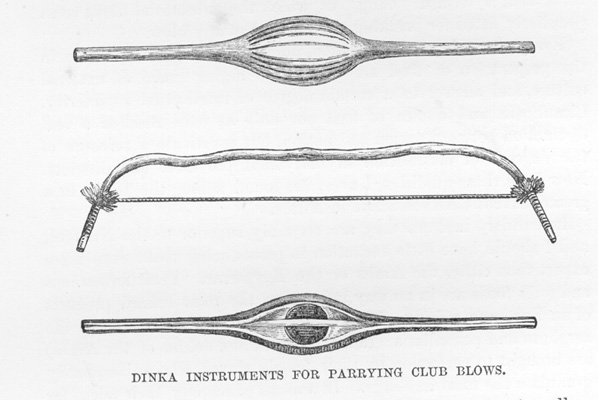Dinka Shields

'Dinka instruments for parrying club blows.'
From Schweinfurth, 1878 (1): 53.
Extract from Plaschke and Zirngibl, African Shields
(p 75)
The truth of the statement that the stick was the prototype of many defensive weapons can be seen by examining three types of wood shields. Their main function - deflecting the blow of one's opponent - became an essential and basic characteristic of the simple pole and parrying shield. It was only with the later development of broad shields that their users were able to defend themselves against the enemy's spears, arrows, clubs etc.
The 'original model' of a wooden pole shield with a concave handle in the middle arose from the necessity of parrying with a piece of wood while protecting one's hand at the same time. Fist protectors together with fighting poles and clubs were used to settle disagreements within the tribe. In armed conflicts with neighboring tribes, however, larger leather shields were employed. Early ethnological articles not only mentioned the simple and modest way of life of the Nilotic herdsmen of Sudan, but also displayed their parrying shields with the description, 'typical weapons of the upper Nile'.
'Kuerr' as the shield in ill. 62 is called, is a product of the Dinka from the swampy lowlands of the upper Nile. Illustration 63 illustrates a slimmer and more elegant design. [both of these shields are very similar to 1884.30.21].
G.Schweinfurth was one of the first to draw attention to the peculiar pole shields of the Dinka. He wrote that their marked preference for clubs and fighting poles led other tribes to call them 'the people of the pole'.
A deep groove runs the length of the inner side of the shield in ill. 62. On the shield next to it the same groove is restricted to the middle section. It can be safely assumed that fighting poles were laid in the grooves.
Extract from Schweinfurth's The Heart of Africa
(pp53 - 54)
The most important weapon of the Dinka is the lance. Bows and arrows are unknown: the instruments that some travellers have mistaken for bows are only weapons of defence for parrying the blows of clubs. But really their favourite weapons are clubs and sticks, which they cut out of the hard wood of the Hegelig (Balanites), or from the native ebony (Diospyrus mespiliformis). This mode of defence is ridiculed by other nations, and the Niam-niam, with whom the Dinka have become acquainted by accompanying the Khartoomers in their ivory expeditions, deride them as 'A-Tagbondo' or stick-people.
Similar conditions of life in different regions, even among dissimilar races, ever produce similar habits and tendencies. This is manifest in the numerous customs that the Dinka possess in common with the far-off Kaffirs. They have the same predilection for clubs and sticks, and use a shield of the same long oval form, cut out of buffalo-hide, and which, in order to insure a firmer hold, is crossed by a stick, secured by being passed through slips cut in the thick leather. But the instruments for parrying club-blows depicted in the accompanying illustration are quite peculiar to the Dinka. As far as I know, no previous traveller has drawn attention to these strange contrivances for defence. They are of two kinds. One consists of a neatly-carved piece of wood, rather more than a yard long, with a hollow in the centre for the protection of the hand: these are called 'quayre'. The other, which has been mistaken for a bow, is termed 'dang' of which the substantial fibres seem peculiarly fitted for breaking the violence of any blow...
Extract from Petherick's Egypt, the Soudan and Central Africa
(p391)
Their arms are lances and clubs; the latter, held in the left hand, is used as a shield to ward off the lances, and to brain the fallen enemy.
Extract from Petherick's 'On the arms of the Arab and Negro tribes of Central Africa,
bordering on the White Nile'
(talk given to the Royal United Service Institution at its evening
meeting on Monday May 7 1860; JRUSI, iv, 13, p173 - 174)
The pastoral Dinkas use only one large and two or three smaller lances, without a shield, a substitute for which is a heavy stick with which they cleverly ward off a coming lance, using it as a club and with it drive their cattle of which they possess large herds. Iron the Dinkas have not, and they are obliged to purchase their lances from their neighbours the Arabs. As a substitute for iron, after insertion in boiling water, they straighten the horns of antelopes and gazelles for lance points. Their method of fighting, as is the case with the whole of the negro tribes with whom I am acquainted, is on foot, as they have no beast of burthen, and, although they are large cattle owners, the ox has never been made serviceable, the neighbouring Bagara Arabs, to carry loads or man.
... Originally Dinka, and subdivided into many families forming distinct tribes, having their language only in common, these negroes, in addition to a stiff club, made from the root of a tree, which they are expert in casting as well as fencing with, carry an instrument like a bow for the purpose of warding off projectiles, and which, with the club, and a lance, or two, are grasped in the left hand, whilst throwing a lance with the right.